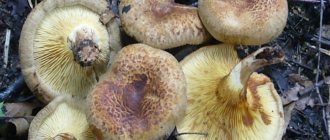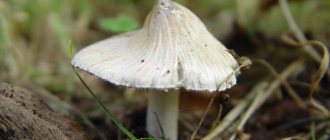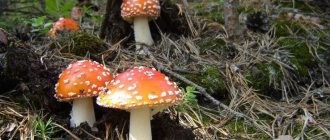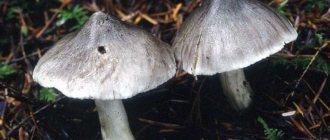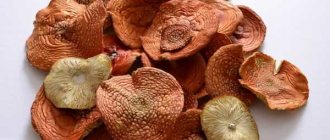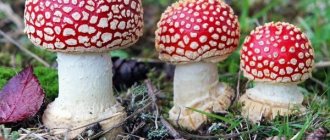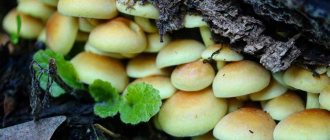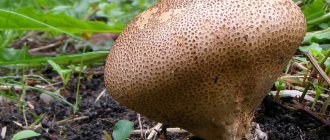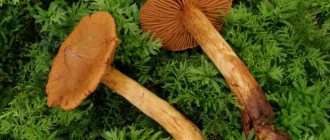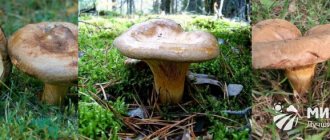The thin pig mushroom (barn mushroom) (lat. Paxillus involutus) was classified as an edible species until 1981. Then, after lengthy chemical and toxicological studies, scientists classified it as a poisonous mushroom, but many mushroom pickers do not agree with this and still continue to collect thin mushrooms along with edible mushrooms.
Description of the thin pig
Thin pig has many popular names - barn mushroom, pig, pig, filly or pig. Until the end of the last century, this variety was considered conditionally edible. Soups were made from it, caviar was prepared, and preparations for the winter were prepared.
The barnyard may look completely harmless and outwardly appears to be quite edible. Many mushroom pickers believe that if you boil, salt or pickle this mushroom for a long time, it can be absolutely harmless.
Reference! The main danger of the pig is that the symptoms of poisoning do not appear immediately. The toxins contained in the pulp do not disappear after processing and accumulate in the body. Long-term consumption of mushroom dishes from pigs causes irreparable harm to the body and over time can even cause death.
To prevent novice mushroom pickers from confusing the pig with edible mushrooms, you need to know what this false variety looks like:
- Mullein grows no more than 10 cm in height. The average diameter of the cap is 20 cm.
- The skin is colored yellow-brown, olive or red-brown, and the shade becomes darker with age.
- The lower part of the cap is grayish, with a slight yellowish or red tint.
- The shape of the cap is round, with a wavy edge. In young specimens it is convex, but with age it becomes flat. Under the cap there are frequent plates.
- The pulp is dense and quickly darkens when cut. It has no pronounced taste or smell.
- The leg is small, up to 3 cm in diameter and no more than 10 cm in height. The surface is smooth, yellow or greenish.
The pig's ear mushroom is found throughout temperate climates. Beginners to “silent hunting” may confuse this species with milk mushrooms, so it is better to look at the pictures of the poisonous mushroom in advance so as not to accidentally put it in the basket.
Edibility Proponents' Arguments
Svinushka is well known to experienced mushroom pickers and is very popular. The first fruits appear long before other mushrooms and delight with a bountiful harvest until late autumn. Fans of the spring forest delicacy consider them very tasty. The question of whether it is possible to eat pig mushrooms will only bring a smile to fans, because this mushroom is popularly called the edible pig mushroom. You just need to boil it longer, from 20 to 40 minutes, after which you can cook as usual.
Proponents of edibility are not embarrassed by rumors of poisoning with this product. Inexperienced foragers can become poisoned if they place an inedible mushroom mixed with edible ones in a basket, which is quite enough to cause a food reaction. In addition, pig mushrooms are very similar in appearance to other poisonous mushrooms. You should know well what pigs look like so as not to confuse them, and then you can safely prepare delicious dishes from them and diversify your table.
The strongest argument in favor of edibility is that throughout our lives our grandparents loved to cook soup, roasts, and pickles from these mushrooms. The main thing is to know how to cook. Absolutely any product can be poisonous if not prepared correctly.
Return to content
Why is the mushroom not edible?
Research by scientists has shown that the pulp of the mullein mushroom contains dangerous compounds muscarine, hemolutin and hemolysin. These substances are not destroyed by cooking, pickling or other cooking methods and accumulate in the body.
Reference! You can only eat fat pigs, and only young specimens that were sent to boil or fry immediately after collection.
The use of pigs as food has the following consequences:
- Poisoning occurs extremely rarely upon first use, although toxins remain in the blood and tissues. If mushrooms are consumed frequently, the concentration of toxic substances increases.
- Harmful compounds form antibodies that destroy red blood cells. As a result, a person’s hemoglobin levels drop, anemia and jaundice develop.
- If you eat pigs frequently and in large quantities, it will lead to severe damage to the liver and kidneys.
It should be remembered that each organism is individual, and no one can say exactly which portion of pigs will be the last.
At the moment, medicine has established that these mushrooms should absolutely not be given to children, pensioners or people with weakened immune systems.
Toxicity
Mycologists examined the filly mushrooms in great detail and found that they should absolutely not be pickled, frozen, consumed salted or fried.
Reference! The high toxicity is explained by the poison muscarine, which is part of the pulp. It is very heat resistant and does not get destroyed even after 3 hours of cooking on high heat.
This poison affects cells twice as negatively as the toxins contained in the red fly agaric. Therefore, to maintain health, it is better to refrain from eating pig mushrooms, and give preference to the more well-known and guaranteed safe mushrooms - butterdish, honey mushroom, poddubnik, podolkhovik or obabka.
Poisonous properties
The toxicity of a pig does not appear immediately. As a rule, symptoms appear after repeated consumption of food.
Note! The difference in the severity of symptoms depends on your overall health and the amount of mushrooms eaten. Even if you carefully clean and process these mushrooms for a long time, symptoms of poisoning will still appear over time.
Intoxication from eating inedible mushrooms is expressed as follows:
- The person experiences diarrhea, vomiting, and severe abdominal pain. In the initial stages, it can be relieved with simple medications, but it intensifies with repeated consumption of mushrooms.
- Over time, hemoglobin in the blood decreases, but its level increases in the urine.
- Due to impaired renal function, urination first decreases and then almost completely stops. Problems with the liver cause jaundice.
At the first symptoms of poisoning, call an ambulance. Unfortunately, there is no effective treatment for such poisoning, so it is extremely important to consult a doctor when you notice the first symptoms. Doctors will begin to cleanse the blood and tissues of toxins, and serious consequences will be avoided.
Safe recipes
Svinushki are mostly prepared marinated or salted. But no matter what recipe you choose, you need to secure them first.
Note: Processing begins with cleaning. There is no need to remove the skin from the cap from the barn, but it is worth cleaning thoroughly of debris and sand, especially between the plates on the inside. You can use a soft brush or sponge. Rinse several times in running water.
Soaking and triple boiling will help get rid of toxins and muscarine:
- Soak the mushrooms three times in a well-salted solution. Leave for at least 5 hours each time.
- Boil them in salt water three times too. Take about a teaspoon of salt per kilogram of raw materials. The first time you need to cook after boiling for 5 minutes, the second time - 30 minutes, and the third - 45 minutes. Each time fill the product with cold water, not boiling water. When changing the water, rinse the mushrooms well.
- Do not think that young specimens need to be cooked less, this is a mistaken opinion. In addition to the waiting time, you can determine readiness by “immersion” in the pan. “Submariners” are ready-made mushrooms, and those that float on top are not yet cooked.
After it has cooled, you can start working on your pickling and pickling recipes. They can also be used in salads or as a side dish. You can freeze it this way and store it for six months. But the main thing to remember is that the barn cannot be used without first soaking and triple boiling! Is it dangerous! That's why pigs are not dried.
Figure 5. Cowweed is usually pickled and salted, but it is also good fried.
So, a few popular recipes. Pickled pigs are considered popular: prepare the marinade. For a liter of water, put: 40 grams of salt, 20 grams of sugar, peppercorns, dill umbrellas, bay leaf. After the marinade boils, throw in the mushrooms (three kilograms), let it boil again and cook for 15 minutes. After this, pass them through a colander, but leave the marinade in a separate bowl. Let the mushrooms dry a little and place tightly in sterile jars. Put the marinade back on the fire, add 20 ml of vinegar essence (70%) and after boiling, pour the marinade over the mushrooms, having previously selected the dill and bay leaf umbrellas, and roll up the jars tightly (Figure 5).
Salted pigs are another popular delicacy. This recipe is suitable for those who have a good cellar or a spacious refrigerator. In this form, the workpiece can be stored at a temperature not exceeding +10°C.
Let's start cooking:
- For pickling you will need enamel or wooden utensils. It is important that the enamel in the pan is not damaged.
- Cut the stems off the cooked mushrooms. Only hats or small pigs are suitable for us. The legs can be used for other purposes, for example, for freezing or frying with potatoes.
- Wash and dry currant, horseradish, cherry leaves, and dill umbrellas. Peel and cut the garlic into slices.
- We will salt the mushrooms in layers. Place salt on the bottom of the vessel, then a layer of mushrooms about five centimeters, then again salt and our herbs with garlic, then again a layer of mushrooms and so on.
- The topmost layer will be salt. Calculate total salt: 120 grams per 3 kg of barns.
- Cover everything with clean, ironed gauze and place it under a press in a cool, dark place for two weeks. We change the gauze every other day. Then we put the pigs into sterile jars, fill them with brine from the tubs and close them with nylon lids.
- In this form, barns can be stored for 4-6 months in the refrigerator or in the cellar. If, when opening such a jar, you notice a suspicious odor or a moldy film on top, then it is better not to risk your health and not consume such a product.
There are quite a lot of recipes and after the preliminary processing described in this article, you can prepare them at your discretion. Fried mushrooms are used, for example, to prepare soups and side dishes.
When boiled, they are suitable for salads. Due to their meatiness, they are very tasty with sour cream sauce or in julienne.
Spreading
To learn how to distinguish pig mushrooms from similar mushrooms, you need to not only know what it looks like, but also where it can grow.
- It is found everywhere, in all regions of Russia with a temperate climate. It is also found in some regions of Eastern and Central Europe.
- The mushroom can grow not only in deciduous and mixed forests, but also in coniferous forests. It is found in pastures and even in city squares.
- Prefers to grow on fertile soils and in shady places with high humidity.
Peak fruiting occurs in the summer months and September. However, if the summer is dry, the fruiting bodies may not develop.
First aid
If you suspect you have eaten a poisonous mushroom, do not wait until symptoms appear. Get help by calling an ambulance . If a person who has eaten a mushroom falls and goes into anaphylactic shock, call an ambulance immediately, since you most likely will not be able to help him on your own.
Before the doctor arrives, you must:
- do a gastric lavage (give 1–1.5 liters of a weak pale pink solution of potassium permanganate to drink);
- give sorbents (activated carbon at the rate of 1 g per 1 kg of body weight);
- put heat on your stomach and legs;
- give the patient strong tea;
- give a laxative (“Sorbitol” at the rate of 1 g per 1 kg of the patient’s weight).
The arriving ambulance team will send the patient to a medical facility, where further measures will be taken . The patient will be prescribed treatment and a diet that he will adhere to for the next 30 days.
Important! A poisonous mushroom can cause hallucinations. The condition is accompanied by confusion, muscle weakness, agitation, rapid heartbeat and headache.
Answers to frequently asked questions
The edibility characteristics of the thin pig mushroom are a source of much debate, and many wonder whether this mushroom can be beneficial.
Here are answers to the most common questions regarding barnyard fungus:
- Can pig meat be beneficial? Scientists have proven that the pulp of the mushroom contains dangerous toxins that are easy to poison. But in Chinese traditional medicine, this variety is used for weight loss, as a remedy for seizures and for muscle relaxation.
- Is it possible to buy pigs on the open market? Officially, the ban on trade in these mushrooms has been in effect since 1981.
- Are there edible varieties? Yes, a fat pig is quite suitable for eating. It is used to prepare soups, gravies and stewed in sour cream. And it is also used to make winter preparations in marinade and cold and hot pickles. But the differences between the thin and thick varieties are so insignificant that only an experienced mushroom picker can distinguish them. Beginners are advised to pick safer mushrooms, such as saffron milk caps or saffron mushrooms.
- What safe recipes for making thin pork exist? There is no such. Even if you properly clean the fruiting bodies, boil them for a long time or sterilize them, dangerous toxins will remain in the pulp. Salt and vinegar also do not destroy them, so boiled, pickled and canned pork ear mushrooms are equally dangerous.
- Is it possible to freeze thin pork? Toxins remain in the pulp even after freezing. Even shock freezing at extreme temperatures cannot eliminate them.
Location
The cowshed is common in many Russian regions and performs well even in harsh climatic conditions.
Mushrooms respect moist, loose soil, preferably under birch, oak, bushes, on the edge and in a clearing near a swamp. They form large colonies. It is very rare to encounter a solitary growing specimen. Found until late autumn.
Mushroom barn. The illustration for the article is used from the site wikigrib.ru
Let's sum it up
Thin mushroom is a dubious mushroom that was previously considered edible. Some mushroom pickers still like to cook them. But you can’t preserve or salt pigs. They contain a dangerous poison that accumulates in the body and over time causes serious disruptions in the liver and kidneys. Consumption of such mushrooms in large quantities can be fatal, so it is better not to risk your health, but simply collect and eat safer types of forest mushrooms.
Information sources
- Elin Yu. Ya., Zerova M. Ya., Lushpa V. I., Shabrova S. I. Dari lesiv. — K.: Harvest, 1979
- Zerova M. Ya., Elin Yu. Ya., Koz'yakov S. M.
Mushrooms: natural, mentally natural, unnatural, destructive. — Kiev: Harvest, 1979 - E. Lawrence, S. Harniess Mushroom and other fungi. Identification guides British & European. // Flame tree publishing. London, 2007
Conclusion: can it be eaten?
Everyone should be responsible for their own health and decide whether they can eat a product such as pig mushroom or not.
The mention of grandparents, whose lives fell on harsh years, is completely inappropriate in this case. In conditions of malnutrition, not entirely edible foods could save people from starvation. In extreme conditions, the body is sometimes able to create an antidote and react completely differently than in normal conditions.
Many edible fruits of remarkable quality and taste grow in the forests and fields of our country. There is no point in tasting and eating everything. It makes more sense to simply accept: pig mushroom is an inedible mushroom.
